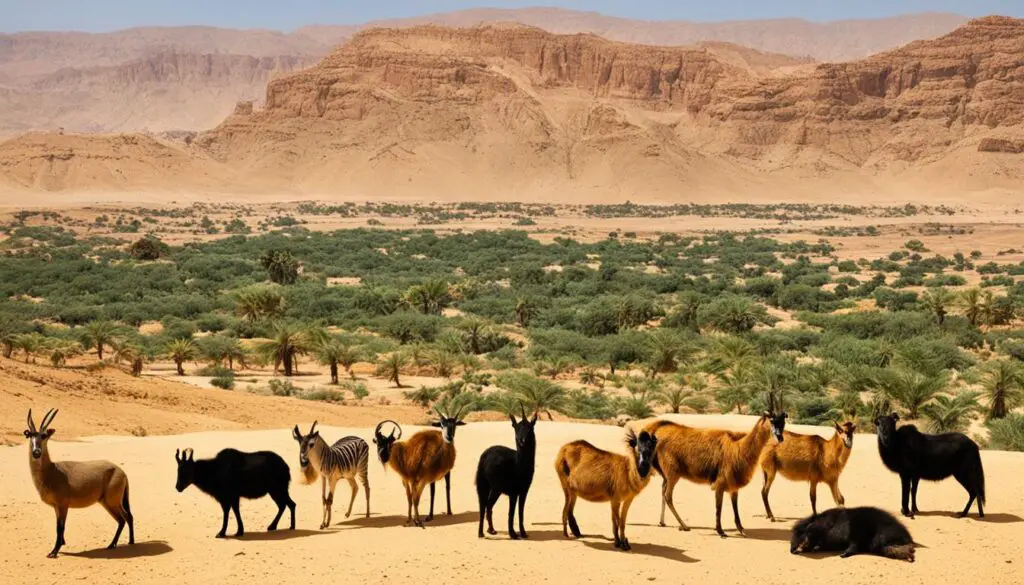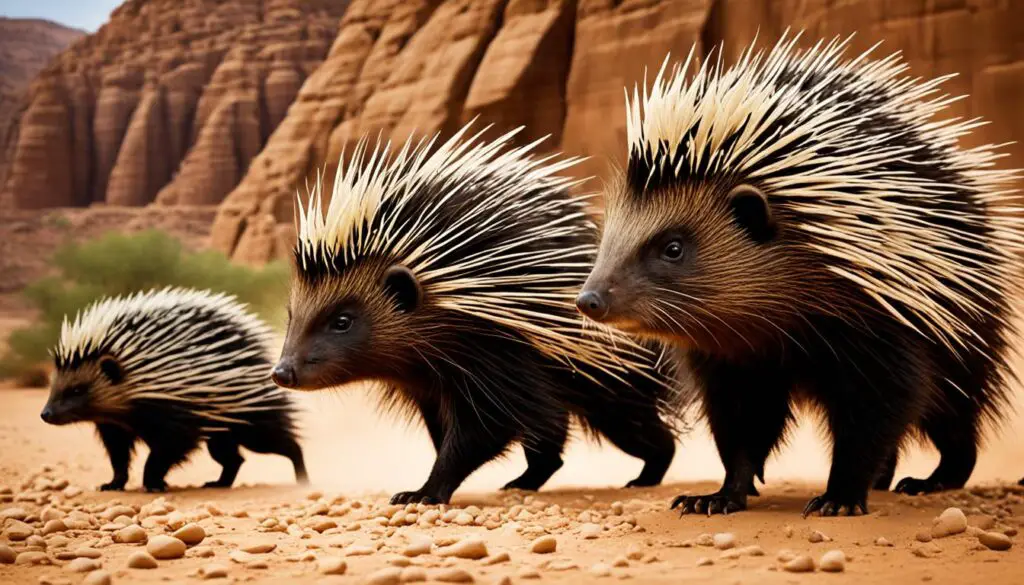Jordan is home to a diverse range of wildlife, with unique animal species found throughout the country. From the majestic Arabian oryx to the elusive sand cat, Jordanian wildlife showcases the richness of its fauna. The country’s varied landscapes, including deserts, mountains, and coastal areas, provide habitats for a wide array of animal species.

Endangered animals in Jordan, such as the Nubian ibex and the white-headed duck, highlight the need for wildlife conservation efforts in the region. Jordan is dedicated to protecting its animal species and preserving the country’s biodiversity. The establishment of protected areas and the implementation of captive breeding programs are vital steps taken to safeguard the future of Jordanian wildlife.
Key Takeaways:
- Jordan boasts a rich diversity of animal species in various habitats.
- Endangered animals in Jordan, like the Nubian ibex and white-headed duck, require conservation efforts.
- The country is committed to protecting its wildlife through the establishment of protected areas and captive breeding programs.
- Jordan’s unique landscapes, including deserts and mountains, support a wide range of animal species.
- Biodiversity preservation is essential for the long-term survival of Jordanian wildlife.
Conservation Efforts in Jordan
Jordan, known for its diverse wildlife and natural resources, prioritizes conservation efforts to protect its unique animal species. At the forefront of these efforts is the Royal Society for the Conservation of Nature (RSCN), established in 1966.
The RSCN plays a pivotal role in safeguarding Jordan’s wildlife and natural habitats. Through the establishment of protected areas across the country, the RSCN ensures the preservation of critical ecosystems that support a wide range of animal species. These protected areas serve as havens for endangered animals and promote biodiversity conservation.
An integral part of the RSCN’s conservation strategy is the implementation of captive breeding programs. These programs focus on breeding and reintroducing endangered animal species back into their natural habitats, thereby revitalizing populations that were once on the brink of extinction.
One notable success story of the RSCN’s captive breeding programs is the revival of the Arabian oryx population in Jordan. Through careful conservation efforts, the Arabian oryx, a species once on the verge of extinction, has seen a remarkable increase in numbers within the country.
“The RSCN’s commitment to wildlife conservation and the implementation of protected areas and captive breeding programs are vital for the long-term survival of Jordan’s precious animal species,” says Dr. Ahmed Al-Nsour, a leading conservation biologist at the RSCN.
By actively collaborating with local communities, educational institutions, and international organizations, the RSCN continues to enhance awareness and appreciation for wildlife conservation in Jordan. These collective efforts aim to ensure the sustainable coexistence of humans and animals, fostering a harmonious and thriving ecosystem for generations to come.
| Conservation Effort | Description |
|---|---|
| Protected Areas | Establishment of designated areas to preserve critical ecosystems and provide a safe haven for endangered animal species. |
| Captive Breeding Programs | Implementing breeding and reintroduction programs to increase populations of endangered animal species. |
| Collaboration | Working with local communities, educational institutions, and international organizations to promote wildlife conservation awareness and education. |
Mammals of Jordan
Jordan is a haven for a diverse range of mammal species, each uniquely adapted to its desert landscapes. These remarkable creatures play vital roles in maintaining the delicate balance of the ecosystem. Let’s explore some of the notable mammals that call Jordan home:
Arabian Oryx
The Arabian oryx, a symbol of endurance and resilience, was once extinct in the wild. Thanks to dedicated conservation efforts, this magnificent antelope has been successfully reintroduced to Jordan’s protected areas. Its striking white coat and elegant horns make it a truly iconic species.
Striped Hyena
The striped hyena is another fascinating mammal found in Jordan. With its distinctive striped fur pattern and powerful build, this nocturnal predator prowls the vast desert landscapes. Its role as a scavenger helps maintain the ecological balance by cleaning up carcasses and preventing the spread of disease.
Egyptian Mongoose
The Egyptian mongoose, a nimble and cunning creature, can be found in various regions of Jordan. This agile carnivore has a slender body, short legs, and a long tail. Its ability to hunt snakes, scorpions, and rodents is critical in controlling populations and maintaining the delicate ecosystem.
Nubian Ibex
The Nubian ibex, a sure-footed mountain climber, dwells in the rugged terrain of Jordan’s nature reserves. With its impressive horns and remarkable agility, this herbivorous mammal has adapted to the harsh conditions and vertical cliffs of its habitat.
Dorcas Gazelle
The graceful dorcas gazelle roams the arid plains of Jordan, using its excellent speed and agility to evade predators. With its sandy-colored coat and distinctive black stripes, this endangered species is treasured for its beauty and symbolizes the importance of wildlife conservation.
Sand Cat
The sand cat, a master of desert survival, thrives in the arid regions of Jordan. With its thick fur that insulates it from extreme temperatures and large paws that allow it to move effortlessly across the sand, this elusive feline is perfectly adapted to its harsh environment.
Honey Badger
The honey badger, known for its fearless nature and remarkable strength, can be found in Jordan’s desert regions. This tenacious mammal is an integral part of the ecosystem as it helps control rodent populations and contributes to the overall balance of the habitat.

The unique diversity of mammal species in Jordan highlights the country’s commitment to wildlife conservation and the preservation of its natural heritage. By protecting these extraordinary creatures and their habitats, Jordan ensures a sustainable future for its wildlife and the invaluable biodiversity they contribute to.
Birds of Jordan
Jordan, located at the crossroads of three continents, serves as a crucial hub for migratory bird species. Every year, more than 220 migratory bird species pass through the country during their annual migrations, while another 150 species call Jordan their permanent home.
The Gulf of Aqaba, with its warm and clear waters, attracts a diverse range of bird species, making it a sought-after destination for birdwatchers. This vibrant ecosystem supports a variety of marine bird species, thanks to the thriving coral reef that provides shelter and food.
Unfortunately, not all bird species in Jordan are thriving. Some, like the endangered white-headed duck and sociable lapwing, face a precarious future. Conservation efforts are underway to protect and preserve these bird species, ensuring their survival for future generations to enjoy.

Notable Bird Species in Jordan:
- White-headed duck
- Sociable lapwing
By safeguarding the habitats of migratory and native bird species, Jordan is playing a vital role in the preservation of avian biodiversity. Whether soaring through the sky or finding solace among the vibrant coral reefs, the birds of Jordan captivate and inspire nature enthusiasts from around the world.
Reptiles and Fish in Jordan
Jordan is home to a diverse array of reptile species, including snakes, lizards, and turtles. These fascinating creatures can be found in various habitats throughout the country, from the arid deserts to the lush nature reserves.
The nature reserves in Jordan play a crucial role in providing protected habitats for reptiles to thrive. These reserves offer a safe haven for these reptilian residents, allowing them to carry out their natural behaviors and contribute to the overall ecosystem.
“The nature reserves in Jordan provide essential protection for reptiles and help in preserving their unique biodiversity. These areas serve as important breeding grounds and nesting sites for many reptile species.”
In addition to reptiles, Jordan is also home to a rich diversity of fish species, particularly in the Jordan River and the Gulf of Aqaba. The Gulf of Aqaba, with its crystal-clear waters and vibrant coral reefs, supports over 1,000 different species of fish.
“The Gulf of Aqaba is a paradise for fish enthusiasts and divers alike. Its rich biodiversity and stunning underwater landscapes attract visitors from around the world.”
Whether exploring the reptile habitats in Jordan’s nature reserves or diving into the colorful world beneath the waves in the Gulf of Aqaba, visitors can witness firsthand the incredible diversity of reptiles and fish species that call Jordan home.
Conclusion
Jordan, with its diverse landscapes and geographic regions, is a haven for wildlife enthusiasts. The country is home to a wide range of animal species, showcasing the rich biodiversity found in the region. From the fascinating desert-dwelling mammals to the migratory birds that pass through during their annual migrations, Jordan offers a unique wildlife experience that captivates visitors.
The commitment of Jordan towards wildlife conservation and biodiversity preservation is evident through its establishment of protected areas and the implementation of captive breeding programs. These initiatives aim to protect and preserve endangered animal species, ensuring their long-term survival. The Royal Society for the Conservation of Nature, established in 1966, has played a significant role in these conservation efforts and continues to make strides in safeguarding Jordanian wildlife.
Exploring Jordan’s ecosystems reveals the country’s astonishing array of wildlife. The marine life in the Gulf of Aqaba, with its vibrant coral reefs, supports a diverse range of fish species. At the same time, reptiles such as snakes, lizards, and turtles thrive in the country’s nature reserves. The unique habitats provided by Jordan’s various regions contribute to the survival and flourishing of these animal species.
Jordan’s dedication to wildlife conservation and the preservation of its precious biodiversity ensures that future generations will continue to marvel at the country’s remarkable animal kingdom. Whether it is observing the iconic Arabian oryx in the desert or witnessing the annual spectacle of migratory birds, Jordan offers a truly remarkable wildlife experience that highlights the importance of protecting and cherishing our natural world.
FAQ
What is the Royal Society for the Conservation of Nature?
The Royal Society for the Conservation of Nature was established in 1966 to safeguard Jordan’s natural resources and protect its wildlife.
What measures has the Royal Society for the Conservation of Nature implemented to conserve and protect endangered species in Jordan?
The organization has established protected areas and implemented captive breeding programs to conserve and protect endangered animal species in Jordan.
Which mammal species can be found in Jordan?
Jordan is home to various mammal species, including the Arabian oryx, striped hyena, Egyptian mongoose, Nubian ibex, dorcas gazelle, sand cat, and honey badger.
What is the significance of Jordan for migratory bird species?
Jordan’s location at the intersection of three continents makes it a vital stopover for migratory bird species. Over 220 migratory bird species pass through Jordan during their annual migrations, while 150 species are native to the country.
What are some endangered bird species found in Jordan?
Some endangered bird species found in Jordan include the white-headed duck and the sociable lapwing.
What reptile species can be found in Jordan?
Jordan is home to various reptile species, including snakes, lizards, and turtles.
What is the diversity of fish species in Jordan?
Jordan has a diverse range of fish species, particularly in the Jordan River and the Gulf of Aqaba. The Gulf of Aqaba is home to over 1,000 species of fish.
